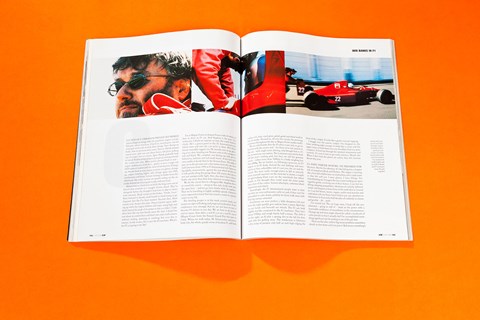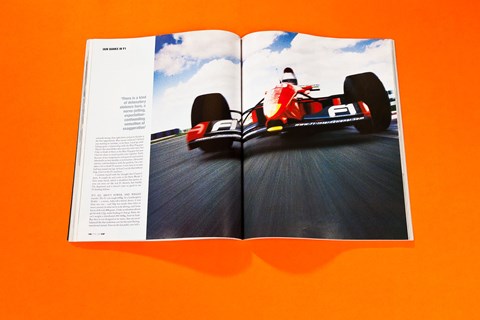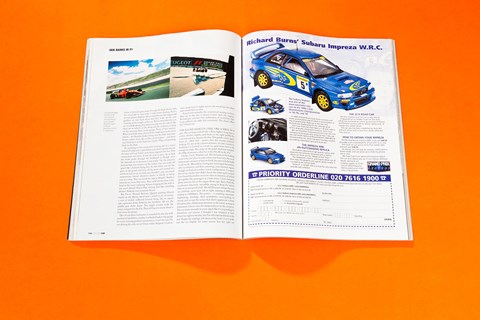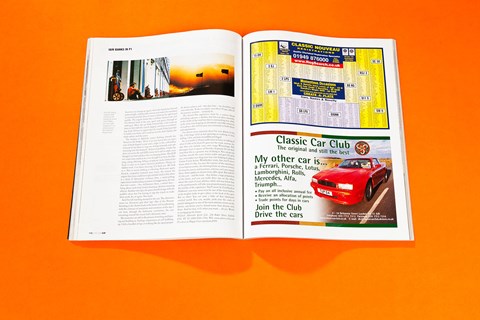Being behind the wheel of Formula One car is about as far-removed from any other motoring experience as you can imagine. Some might say indescribable. Not if you are one of the country’s leading novelists
Clutch out. Vibration previously merely intense leaps to merge with the psychotic engine scream. Exit pits, wheel twitching. Clutch in, second gear, aim for a cone gate on far side of track. Gear change. Turn. Stamp on brake. Aim to just miss two cones. Turn it. Hands twisted round now, right one just above knees, left glove just poking out of cockpit into airstream. Apex. Hands gradually back to lateral. Feed in power progressif, progressif, aiming towards the corner exit cone. More power, pressed back in seat – engine making my teeth buzz – glance at revs, a single red LED numeral underneath the slither of windscreen. Change up, thrown back in seat, engine screams, rev glance, change up, engine howling higher still, change again into fifth, engine howling higher still, change again into fifth, acceleration still fierce, helmet starting to buffet from the slipstream like some maniac on speed’s sitting in the air intake behind me playing pat-a-cake with my head.
Almost time to think here on Golf, the long curve out of Estoril that unwinds to a straight. Cones ahead. They’re alongside before the thought’s even had time to skip to short-term memory. Really stamp on the brakes. ‘I brake, I wait.’ Slam forward to fourth, muff fourth to third trying to go diagonal. Just like I’ve been warned. Second, then. Haul round, even sharper this time. Progressif power again, shifting up while the engine bellows and rasps, rising high and shrill towards the peak of its power as fast as a bike’s. I take what feels like my first breath since the start. I think I’m just about in control here and that’s two and a half corners without stalling, spinning or crashing, but wow this is intense. Lordy mama; this is just the F3 machine. What’s the F1 car going to be like?
I’m at Magny-Cours in deepest France with 14 others; all here to drive an F1 car. And Stephan is the man. Our instructor, I think we imprint on him like newly hatched chicks. He’s a garcon grand in the F1 International team which owns and runs the cars we’re about to drive. He’s black-haired, smoothly rugged, tan. He literally sizes us up, glancing at us, then handing out Nomex suits in the company’s red and black. We complete our kitting up with gloves, balaclavas, helmets and red suede boots. A few have their own outfits; I decide they’re the Serious Guys. The racks of gear are in the pit units just a few metres from the cars: three red Laurousses from 1994 in F1 International red. I lean one leg lightly, momentarily, against the rear wheel of one and it rolls gently across the garage floor. Of course, the cars are not just unexpectedly light, they also don’t have a handbrake, any more than they have silencers or starter motors. We do the circuit first in a Peugeot 806. Stephan drives us round the course – sweep to this side, brake now, skirt the apex here – and we go very slowly while he explains. Then we’re travelling at highly unlikely speeds. I honestly never expected to travel that fast around round a corner in a people carrier in my life.
The briefing proper is in the track control room, and majors on degressif braking and progressif acceleration. It also emphasises we are not here to race or become F1 drivers in one day. We are here to do no less, and no more, than drive a real F1 car on a real F1 course (Magny-Cours hosts the French Grand Prix this year on 2 July. Where we walk today, M. Schumacher and everybody else, the whole, gaudy circus of modern F1, will walk, sashay, roll, limp, pout, grin, growl and wheel itself in just six weeks. Around us, all over the circuit, the preening continues throughout the day as Magny-Cours readies itself).

We are told bluntly that the F3 drive is not only to get us familiar with the course and – for those of us not used to it – with single-seater driving, vital though that is; it’s also to weed out any nutters. The Laurosses may not be fresh off last year’s starting grid but they are still the genuine article – rather more than 700bhp in a body weighing less than 600kg. No rev limiter, no following a pace car, no F3 engine in an F1 body. Instead the real shebang, and once you’re inn that carbonfibre tub it’s just you, the car and the circuit. You have easily enough power to kill or seriously injure yourself anywhere on the track (we’re shown a couple of ugly-looking black scars on the start-finish line where people in F3s thought they could mash the faster pedal once clear of the corner. Instant wheelspin, catherine-wheel impression and slam!)
Accordingly, the F1 International people want to find out who are over-enthusiastic early on, and, if they can’t be persuaded to calm down, politely let them walk away with their lap money refunded.
Conditions are near perfect; a little dampness left over from the night quickly goes and we have a sunny April day on our hands and beneath our wheels. The F3 cars look slightly toy-like compared to the F1 machines. They have 170bhp and weigh barely half a tonne. The shift is on the right; a H plus a sprung slot to the left for first, used only for pulling away. The windscreen is hilarious; a thin scrap of Perspex only half an inch high ridging the front of the cockpit. It looks like a giant’s toe nail clipping. I wriggle into the narrow cockpit. I’m strapped in; the lower webbing tight enough to feel like a corset and the upper straps so hard down over my shoulders I feel my spine compress. A final run through the minimal instruments and controls. It’s now I start to get really nervous. Mouth dry. When I first tried the gloves on earlier, they felt clammy. Know why now.
F3s have starter motors. I’m prepared for the noise. Not for the vibration. It’s like falling into a hopper full of maxed-out Black and Deckers. The engine is buzzing like a hive full of killer bees on methedrine and it really wants to share this with you. I wear glasses, I have filings, I’m forty-bleeding-six. I imagine the tiny screws holding my specs together gently revolving out of their frames. I can feel my fillings adopting sympathetic vibrations of a wholly different nature and frequency from the teeth they’re housed. I can feel bones, sinews, organs, under-used muscles and individuals cells my brain hasn’t had to pay attention to in four-and-a-half decades all suddenly in chorus going what..the…fuck?
I’m second out. The car leaps away, I back off, the revs plummet – going to stall it! – back on the power with a reasonable semblance of smoothness in the circumstances. Change up and what might almost be called a modicum of calm prevails so that I actually feel I’ve achieved something just by making it out of the pit lane.
These are the rules: yellow flag means problem ahead, so slow down until you pass it. Red mean’s something’s seriously wrong, slow right down and go to the pits at the first opportunity, Blue means someone’s behind you wanting to overtake, so let them. I end up establishing quite a relationship with the Blue Flag guys. They’re the same blokes who wear the other ones, but I like to think of them as the Blue Flag guys because I feel we spend so much quality time together. Partly because of my inexperience and general cautiousness (absolutely no way timidity or nervousness, obviously) and my cack-handedness with the gearbox, I’m overtaken in both F3 sessions. I even have to re-start half-way round one lap. At least I can do that without help. Can’t in the F1 machines.
I content myself with the thought that I haven’t spun. A couple do and come in for Stern Words. I have some lunch, which is doubtless fine (pasta; so you can even eat like real F1 drivers), but frankly I’m dispirited and it doesn’t taste so good to be. F1 briefing follows.
It’s all about the power, and weight transfer. The F1 cars weigh 600kg. In a Lamborghini Diablo – a maniac, kaka off-a-shovel device if ever there was one – each bhp has nearly three kilos to move around. In what we’re to be driving, each horse only has to shift 800 grams. Under acceleration drivers get hit with 2.5gs, under braking it’s four gs. Static, the car’s weight is distributed 240/360kg front to back,. But they’re not designed to be static, they are never balanced like that underway save for the most fleeting, transitional instant. Foot on the fast pedal, over half a tonne of pressure goes down through the back wheels, with the remainder to steer with. Under severe braking there’s even greater disparity. Never mind the fact that the engine and gearbox are way back there and they make up the vast majority of the weight of the car. Never mind that the cars are so solidly spring that when you step into the tub it’s like there are no wheels on the thing and the undertray is lying on the concrete floor of the garage. None of that matters. When you brake hard, almost all of the weight goes to the front wheels – the Brembo brakes biting into the dark chocolate brown carbon discs like an Orca with lockjaw – and those vast rear tyres have barely 25kg each pressing them into the deck.

Try jumping on the accelerator coming out of a corner and you’ll snap into a spin before you’re foot’s a quarter-way to the stop and way before your brain registers the fact. Our instructions are strict; if you do start to spin, try to kick the brake pedal through the bulkhead as though your life depends on it, because it just might. For the precious instants that you remain on the tarmac you can scrub off speed like a bastard doing this. So that when you hit the grass or the gravel and have all the poise and control of a just-born foal on an ice-rink, you shouldn’t carry too much momentum toward whatever barrier is finally bringing you to a stop. ‘You can break your legs at 60mph,’ Stephan reminds us, more than once. You could almost sense every head in the room replaying Schuey charging for the wall at last year’s British Grand Prix, trailing dust like vanishing dreams. Nobody even mentions Senna.
But I’m in. Trussed. Nervous. Quietly quaking. Gloved hands on the Momo wheel (not a wheel at all, of course; a sort of stickily rubbered horned thing, like an equals sign squeezed down between two brackets) Ah yes, the paddle gear shifts. Great. This might make life easier compared to the F3s. Then all I have to worry about is four times the power.
One of our three Laurosses is scrapped for the day with mechanical problems, another is wheeled back to the garage for some running gearbox maintenance. I can’t be sure if I’m not driving the only car we’ll have today. Suppose I crash it, even small time? I might survive the wreck but the other guys would skin me alive.
A push start (actually, the air-powered starting machine they use in the pits is almost noisier than they engine). Second gear selected. Five millimetres of accelerator (like I can calibrate my ankle that accurately). The shout ‘Allez! Go!’ Clutch out.
The sound assaults. I feel like a shell in a gun. The car leaps forward like a Navy fighter slung from a carrier. Feather slightly, pull back on the right paddle for second, exit pits. Assume the line. First gentle corner again, burst of – Holy shit! – power, then the counter-intuitive braking. It’s not really counter-intuitive, it’s just counter to anything I’ve learned in a road car, apart from how to do emergency stops. You stamp on the pedal. And stay stamped. It’s 40kg of pressure called for in the F3s; 80 in the F1s.
‘I brake, I wait’ Stephan said. The first part of the braking zone is the one place in each corner you have even the most microscopic amount of time to think, because initially, brake is all you do. Meanwhile, having just rearranged themselves after acceleration and then cornering, your internal organs struggle to find yet another novel configuration. I suspect bits of my insides that didn’t know the other parts existed have found themselves on term close to intimate, all jellied up together like passengers in a tube train. I start changing down (not too fast, or the engine blows up). Apex. Push the accelerator delicately, smoothly, trying to keep the whole foot on it, not just the ball. The LCD screen swings the revs on a ballistic curve from left to right, starting at 3000 and ending at 13,000rpm. The power…is crushing, awesome, frightening, dazzling. And synesthetic; over-spilling to invade and co-opt the sense that don’t appreciate it from first principles, obliterating divisions in the mind, searing tis impression forever into the deepest places in the memory. The car reacts instantly to every input like it’s responding to intentions, not actions. I thought I was strapped in here almost too tight to breath, but I’m still slammed back in the seat. Forget the earplugs, left them at the hotel. Can’t make our the rev display for some reason but my right ear becomes my change-up signal; when the sound rises beyond pulverisingly, unbelievably intense and makes the transition to seriously painful, then it’s time to flick the right hand paddle. The engine howls like a million tortured cats and I’m thrown back in the seat, again and again, through to sixth gear. Here, the car flicks forward like a fast road car does in first with the clutch slipped, and keeps on accelerating, hard. I’d love to report that the stands flicked past but I couldn’t see them at all, all I could see was the dash display, the track surface, and the cones.

The hairpin at Adelaide comes flashing towards me. Stand on the brakes. There is no real seat in the car, just a sort of back-shaped scoop and a ridge in the carbonfibre forward of my bum to stop my sliding forwards and submarining in the footwell. Technical problem. Under the sliver of screen the red LED claims we’re still in sixth, even though I can feel and hear the car changing down. The LCD rev count stays stuck at sixth, even though I can hear the blipping, rising, whining, falling cacophony inches behind my head. I come in to report and electrical problem. Things are fiddled with,. I sit there, buzzing. Car back out. Me back in it. Not so much shaking as vibrating. Push start again; blasted, catapulted forward once more, the instant the engine fires (you never get entirely used to this, the kind of detonatory violence here, a nerve-jolting, expectation-confounding sensation of exaggeration, the way that tiny causes – five millimetres there, a twitch here – bring about such livid, bowel-churning, skeleton-straining effects). Another two laps; the gears should change with the paddles alone, but I’m having to dip the clutch to make them work. So, in again. Two more.
And I’m left standing stunned in the sun. The afternoon wears on. Everyone gets their laps. Out of the Nomex. Standing in the shower back at the hotel, still reverberating with the clamour of sensations and emotions of the day, I can hear, through the bathroom ventilation, the cars screaming around the circuit half a kilometre away.
My memories are still in the process of etching and burning and bedding in. Feelings, impressions are still bubbling up. I did a handful of laps at nothing like the speed proper F1 drivers achieve and – two days later – my shoulders and arms still ache. To do, to compete, over 60 or 70 laps after all the practice sessions…seriously fit.
The Grand Prix experience must be a curious blend of finding a groove, a rhythm, that lets you drive smoothly, in the midst of the mayhem that is surrounding you, while at the same time keeping an absolutely razor-like extremity of readiness that lets you react instantly to both threat and opportunity.
I’ve driven more intensely than I’ve ever driven in my life. I felt huge relief at not spinning or crashing or even stalling. I felt, and feel, incredibly privileged.
So, is it worth it? If you really want to have an inkling of what it’s like to be those F1 guys (on the track, anyway; the day does not include your own mega Winnebago, Bell Jetranger, Lear or queue of blondes desperate for sex with you,) then this is a genuine way of doing it. You can go out and buy exactly the same tennis racket and gear as the pros use, you might even blag your way into helping paly-in Centre Court before Wimbledon starts, but you’ll never know what it’s like, because the essence of the experience is too human-centric, the defining limits set almost entirely by muscles, nerves and reactions, and you can’t just assume those. Same applies to almost every other sport. But with F1 it’s the cars – and the track – that define a large proportion of the limits, and you can really drive one on the other, where the reach of your abilities, while still way below that of the professionals will take you proportionally closer to the totality of the experience. You’ll never be Coulthard or Hakkinen, you may never even be one of the most hapless make-weights lucky to get a place at the back of the grid. But so what? You can taste a little bit of that fabulously rarefied world. You can, maybe, peek into the souls of people taking part in one of the most extreme events on the planet, and you know you’ve shared more than dreams with them. And for that, if it’s what you want…oh yes. Worth re-mortgaging the house.
